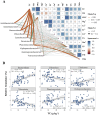Sediment bacterial biogeography across reservoirs in the Hanjiang river basin, southern China: the predominant influence of eutrophication-induced carbon enrichment
- PMID: 40226101
- PMCID: PMC11991844
- DOI: 10.3389/fmicb.2025.1554914
Sediment bacterial biogeography across reservoirs in the Hanjiang river basin, southern China: the predominant influence of eutrophication-induced carbon enrichment
Abstract
A fundamental goal of reservoir ecosystem management is to understand bacterial biogeographic patterns and the mechanisms shaping them at a regional scale. However, little is known about how eutrophication, a major water quality challenge in reservoirs, influences sediment bacterial biogeographic patterns in subtropical regions. In this study, sediment bacterial communities were sampled from 21 subtropical reservoirs in the Hanjiang river basin, southern China, and spanning trophic states from oligotrophic to eutrophic. Our findings demonstrated that eutrophication-driven changes in total carbon (TC) significantly shaped the regional biogeographic patterns of sediment bacterial communities, weakening the "distance-decay" relationships that typically link bacterial community similarity to geographical distance. TC content exceeding a threshold of 13.2 g·kg-1 resulted in substantial shifts in bacterial community structure. Specifically, high TC levels promoted the dominance of copiotrophic bacteria such as Syntrophales (Deltaproteobacteria), Clostridiaceae (Firmicutes), and VadinHA17 (Bacteroidetes), while oligotrophic taxa like Anaerolineaceae (Chloroflexi) and Nitrospirota were prevalent in low TC sediments. Additionally, higher TC content was associated with increased regional heterogeneity in bacterial community composition. Reservoirs with elevated TC levels exhibited more complex bacterial interaction networks, characterized by stronger niche segregation and higher competition compared to low TC networks. Overall, these findings underscore the pivotal role of sediment TC in shaping bacterial biogeography at a regional scale. They provide valuable insights for predicting ecosystem responses to eutrophication and offer guidance for mitigating the impacts of anthropogenic activities on freshwater ecosystems.
Keywords: biogeographic pattern; homogeneous selection; niche breadth; sediment bacteria; subtropical reservoirs.
Copyright © 2025 Yang, Xiong, Tai, Xiao, He, Wu, Zhou, Ren, Wu and Han.
Conflict of interest statement
The authors declare that the research was conducted in the absence of any commercial or financial relationships that could be construed as a potential conflict of interest. The author(s) declared that they were an editorial board member of Frontiers, at the time of submission. This had no impact on the peer review process and the final decision. The reviewer LZ declared a shared parent affiliation with the authors LZ and QLW to the handling editor at the time of review.
Figures







Similar articles
-
Biogeographic Patterns and Elevational Differentiation of Sedimentary Bacterial Communities across River Systems in China.Appl Environ Microbiol. 2022 Jun 28;88(12):e0059722. doi: 10.1128/aem.00597-22. Epub 2022 May 31. Appl Environ Microbiol. 2022. PMID: 35638840 Free PMC article.
-
Spatial and Seasonal Patterns of Sediment Bacterial Communities in Large River Cascade Reservoirs: Drivers, Assembly Processes, and Co-occurrence Relationship.Microb Ecol. 2023 Feb;85(2):586-603. doi: 10.1007/s00248-022-01999-6. Epub 2022 Mar 26. Microb Ecol. 2023. PMID: 35338380
-
Effects of Cascade Reservoirs on Spatiotemporal Dynamics of the Sedimentary Bacterial Community: Co-occurrence Patterns, Assembly Mechanisms, and Potential Functions.Microb Ecol. 2023 Dec 19;87(1):18. doi: 10.1007/s00248-023-02327-2. Microb Ecol. 2023. PMID: 38112791
-
Eutrophication of freshwater and coastal marine ecosystems: a global problem.Environ Sci Pollut Res Int. 2003;10(2):126-39. doi: 10.1065/espr2002.12.142. Environ Sci Pollut Res Int. 2003. PMID: 12729046 Review.
-
Biogeographical Patterns of Bacterial Communities and Their Antibiotic Resistomes in the Inland Waters of Southeast China.Microbiol Spectr. 2022 Aug 31;10(4):e0040622. doi: 10.1128/spectrum.00406-22. Epub 2022 Jun 23. Microbiol Spectr. 2022. PMID: 35735994 Free PMC article. Review.
References
-
- Abell R., Thieme M. L., Revenga C., Bryer M., Kottelat M., Bogutskaya N., et al. . (2008). Freshwater ecoregions of the world: a new map of biogeographic units for freshwater biodiversity conservation. Bioscience 58, 403–414. 10.1641/B580507 - DOI
-
- Anderson M. J. (2014). “Permutational multivariate analysis of variance (PERMANOVA),” in Wiley StatsRef: Statistics Reference Online (Hoboken, NJ: John Wiley & Sons, Ltd; ).
LinkOut - more resources
Full Text Sources

